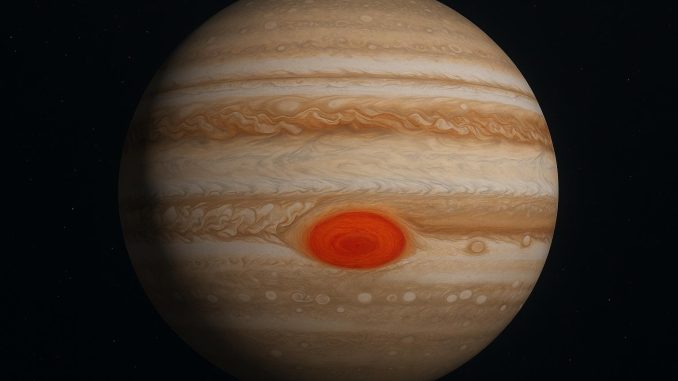
Understanding Jupiter’s Giant Red Spot
Jupiter’s Giant Red Spot is one of the most iconic features of our solar system, known for its striking appearance and unpredictably violent nature. This colossal atmospheric storm has intrigued scientists and astronomers for centuries. Here, we delve into the reasons behind its formation and persistence.
The Formation of the Giant Red Spot
The Giant Red Spot represents a high-pressure anticyclonic storm prominently located in Jupiter’s southern hemisphere. It has been continuously raging for at least 350 years, underscoring its immense power and stability. This enormous storm exemplifies the complexities and dynamic nature of Jupiter’s atmosphere. Jupiter, primarily composed of hydrogen and helium, lacks a solid surface, prompting fluid and dynamic atmospheric conditions.
One of the crucial elements contributing to the formation of the Giant Red Spot is Jupiter’s rapid rotation. The planet completes a turn on its axis approximately every ten hours. This rapid rotation rate heavily influences the planet’s weather systems and causes a pronounced Coriolis effect. On Jupiter, this effect is far more intense than on Earth, compelling winds to swirl at tremendous speeds. The rapid rotation and the Coriolis effect combine to give rise to massive storm systems, including the Giant Red Spot.
The persistence of such phenomena over centuries raises fascinating questions about the energy sources that sustain these storms. Researchers have proposed that heat emerging from Jupiter’s core may contribute significantly to fueling these colossal atmospheric events, fostering their longevity and stability.
The Size and Scale
The sheer scale of the Giant Red Spot adds another intriguing facet to its character. The spot stretches approximately 16,350 kilometers in width, large enough to fit the Earth inside it. This expansive scale underlines the extreme atmospheric conditions present on Jupiter. The vast size is indicative of the immense energy and dynamics at play in Jupiter’s atmosphere, offering a hint into the planet’s complex meteorological phenomena.
Understanding the mechanisms that sustain the size and scale of the Giant Red Spot involves examining the interplay between Jupiter’s internal heat, its atmospheric dynamics, and its rapid rotational influence. These forces maintain the storm’s immense structure, presenting an ongoing spectacle that piques the curiosity and fascination of scientists and astronomers alike.
Color and Appearance
A distinct trait of the Giant Red Spot is its dramatic red hue, which differentiates it from other atmospheric features on Jupiter. This red coloration has been a focal point of scientific inquiry as researchers attempt to discern its origins. Several hypotheses seek to explain the spot’s rich color. One suggestion is that the red tint arises from the chemical reactions of atmospheric compounds when exposed to solar ultraviolet radiation. This interaction may lead to the formation of complex organic compounds responsible for the red coloration.
Another theory posits that the red color might originate from the upwelling of sulfur or phosphorus compounds from deeper within the planet’s atmosphere. These materials, upon reaching the upper atmosphere and interacting with surrounding compounds and radiation, could create the iconic reddish hue characteristic of the Giant Red Spot. Understanding the chemical processes at work remains an active area of research and debate among planetary scientists, illuminating not only the nature of Jupiter’s atmosphere but also broader atmospheric processes observable on other planets.
Studying the Giant Red Spot
The continued study of the Giant Red Spot offers valuable insights into understanding Jupiter’s complex and dynamic atmosphere. Ongoing observations and studies, both from Earth and via spacecraft such as the Hubble Space Telescope and the Juno Mission, continue to provide critical data and enhance our understanding of the planet’s atmospheric conditions. These missions have enabled scientists to observe changes in the spot’s size, shape, and color over time, indicating that the spot is not static but subject to continuous change.
Advancements in technology and observational capabilities allow researchers to collect detailed data, facilitating a deeper understanding of the atmospheric dynamics that sustain the Giant Red Spot. For instance, observations have revealed variations in the intensity of the coloration and changes in the cloud patterns surrounding the spot, suggesting shifts in atmospheric conditions.
Researchers are also interested in understanding how the storm has sustained itself for centuries. This ongoing research offers clues about the underlying atmospheric processes on Jupiter and expands our knowledge of the possible mechanisms that sustain long-duration storms on other planetary bodies.
For more detailed insights into Jupiter, the Giant Red Spot, and related astronomical phenomena, consider referring to resources from established scientific organizations such as NASA or the Space.com website.
In summary, while many mysteries of the Giant Red Spot remain unsolved, ongoing research continues to peel back the layers of this astronomical marvel. The study of the Giant Red Spot not only enhances our understanding of Jupiter but also enriches our general understanding of the nature of planetary atmospheres in our solar system. By unraveling the complexities of such a prominent and enduring feature, scientists aim to gain insights into broader atmospheric phenomena both within our solar system and beyond.
